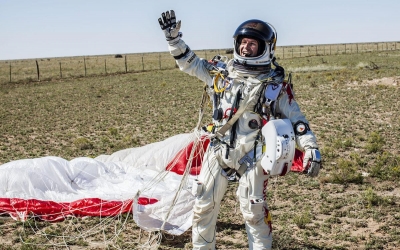
On July 31, 2003, Austrian daredevil skydiver Felix Baumgartner created history by becoming the first flying human to cross the English Channel. A triumph of science, technology, and human will, this skydive was one of Baumgartner’s many such feats.
The English Channel is a narrow arm of the Atlantic Ocean that separates the southern coast of England from the northern coast of France. Also called the Channel, it is among the busiest shipping areas on the planet. The English Channel is also the scene of one of Austrian daredevil Felix Baumgartners historic skydives.
Born in 1969 in Salzburg, Austria, Baumgartner found his destiny at the age of 16. Following his first skydive at that age, he was totally drawn to it and also took to extreme parachuting. He spent a few years with the Austrian military’s demonstration and competition team, improving his aero-acrobatic skills, perfecting his parachute jumping and learning the art of landing on small target zones.
In the 1990s, Baumgartner also started doing base jumping, another dangerous sport that involves leaping off fixed objects and breaking the fall using a parachute. Base, in fact, is an acronym for the categories of objects from which the jump can be made: buildings, antennas, spans (bridges), and Earth (mountains, cliffs, etc.).
Scientific endeavours
Having built a reputation as a daredevil, Baumgartner sought to understand the limits of the human body and what we can achieve with it by training it. Apart from his desire to experience what nobody else had, he also saw his daredevil stunts as scientific endeavours, as they pushed the boundaries of our knowledge and know-how of various facets of his acts.
Before his flight across the English Channel, Baumgartner had already pulled off a number of firsts. In 1999, he completed the world’s lowest ever base jump from the 30m-high arm of the Christ the Redeemer statue in Rio de Janeiro, Brazil. In that same year, he set the world record for the highest parachute jump from a building by jumping off the Petronas Towers in Kuala Lumpur, Malaysia, then the tallest building in the world.
Rigorous training
Baumgartner’s next big feat was his flight over the English Channel, but he didn’t just wing it. On the contrary, the intense preparations actually took three years and included rigorous training-such as strapping himself onto the top of a speeding Porsche to prepare himself for what his planned journey might entail.
Fitted with a specially designed six-foot carbon-fibre wing, an oxygen tank, and a parachute strapped to his back, Baumgartner wore a jumpsuit that was capable of withstanding a temperature of minus 40 degree Celsius. On July 31, 2003, just a little after five in the morning local time to avoid commercial flights, Baumgartner jumped off a plane above Dover flying at a height of 30,000 feet (9,000m). In the next 14 minutes, Baumgartner completed the first freefall flight across the 35km wide English Channel, before safely landing in Cap Blanc-Nez near Calais.
The flight wasn’t without incident, right from the start. Lack of oxygen at the height at which they were flying before he jumped off meant that a cameraman who was following him passed out. When he jumped, his legs and glider got entangled forcing him to cut his glider into pieces.
Extreme cold
Reaching speeds up to 360 km/hour initially, Baumgartner admitted that it was stressful to cope with the initial extreme cold that he experienced. His jumpsuit came in handy, as the temperatures did reach minus 40 degree Celsius. For most of the freefall, he travelled at 220 km/hour.
Additionally, cloud cover meant that he could not see where he was going. As a result, he had to follow his two planes to get across the Channel without getting lost, holding the wing to direct himself.
At the end of his flight Baumgartner said that “it was total freedom” and that he loved every bit of his 35-km ride. While he admitted that this was his “biggest project so far. he also hinted at a “top secret” challenge that was in the works.
That turned out to be his Red Bull Stratos project nine years later. By jumping to the Earth from the edge of space in October 2012, Baumgartner broke a number of records and became the first person to break the sound barrier in free fall. Apart from being an impressive stunt watched live by millions on YouTube plenty of data was also collected from the sky dive. This led to important advances in research pertaining to space and the stratosphere, and helped surmount scientific challenges pertaining to safety equipment and spacesuits.
Picture Credit : Google



